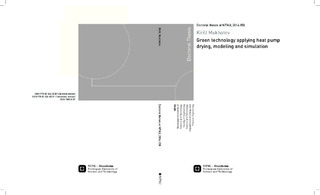| dc.contributor.author | Mukhatov, Kirill | nb_NO |
| dc.date.accessioned | 2014-12-19T11:52:04Z | |
| dc.date.available | 2014-12-19T11:52:04Z | |
| dc.date.created | 2014-07-09 | nb_NO |
| dc.date.issued | 2014 | nb_NO |
| dc.identifier | 733429 | nb_NO |
| dc.identifier.isbn | 978-82-326-0238-4 (printed) | nb_NO |
| dc.identifier.isbn | 978-82-326-0239-1 (electronic) | nb_NO |
| dc.identifier.uri | http://hdl.handle.net/11250/235548 | |
| dc.description.abstract | This work has focused on the development of atmospheric freeze and non-freeze drying applying a heat pump system as an environmental friendly and economically preferable technology compare to vacuum freeze drying. The main reason of the research is a lack of knowledge and information in the literature about the atmospheric heat pump drying, while the more common vacuum freeze drying process is widely covered.
The main objective for developing atmospheric heat pump drying as a new drying technology is the desire to reduce the energy consumption compared to that of vacuum freeze drying while maintaining a high product quality.
One technical solution of atmospheric freeze and non-freeze drying is combining with a heat pump system applying a new environmentally friendly natural refrigerant, such as ammonia or R717. Temperature programs make it possible to customize products for desired qualities and properties, such as color retention, instant rehydration and aroma preservation.
Drying is one of the most important industrial processes, and a technology used worldwide for food processing. The vacuum freeze and high temperature drying are both well-known and extensively applied conventional technologies that have the drawback of high energy consumption. This provided the opportunity for heat pump drying development, in order to decrease operational costs while preserving the quality of the products. Heat pump drying is a relatively new technology developed at NTNU. It unifies the drying and heat pump cycles that allows energy recovery for reheating the drying air.
An analysis was made on the technological aspects, product possibilities, physical properties of products, drying kinetics and modeling.
This work covers the drying of green peas, applying a laboratory heat pump dryer. The drying conditions and processing time are the most important parameters for modeling and scalingup the process. Additionally, the temperature, relative humidity and residence time are essential for understanding changes in product properties, and fundamental for the designing and dimensioning of large-scale drying processes.
Therefore, the various tests were done at many different temperature regimes, from -5°C to 45°C, and at varying levels of relative humidity. Some of the drying tests applied additional equipment, such as an air humidifier, infrared lamps and an oven to get the specific temperature or moisture content of the tested product. All the drying tests were performed, and each run was done in a period of three hours using a fluidized bed mode. The results on kinetics and final moisture content indicated that temperatures and relative humidity levels lead to changes in the moisture removal rates from the material as well as the quality of the product. Studies were also made to investigate the influence of drying conditions and time on product parameters such as color and water activity.
This work also proposes a numerical solution for the moisture content in order to describe the drying kinetics and effective mass diffusivity. The results in this work can be useful since it reduces the number of drying experiments to be tested at a wide range of drying conditions.
The proposed models have been validated by experiments with acceptable deviations. It helps in establishing the temperature and time schedule in a preliminary study on scaling up lab dryers to a pilot or commercial drying plant. This is also a good platform for further research oriented towards the unification of available laboratory data in the heat pump drying of vegetables to the overall simulation program.
The coefficient of performance (COP) and specific moisture extraction rate (SMER) were calculated to characterize the energy efficiency and water removal capacity of the heat pump drying process. Ammonia or R717 was selected as the working fluid due to its thermal properties and for being an environmentally friendly refrigerant. Regarding greenhouse gases (GHGs), ammonia is a natural fluid which has zero ozone depletion potential (ODP) and zero global warming potential (GWP), that makes heat pump drying a competitive and efficient drying technology with a minimum impact on climate change. | nb_NO |
| dc.language | eng | nb_NO |
| dc.publisher | Norges teknisk-naturvitenskapelige universitet, Fakultet for ingeniørvitenskap og teknologi, Institutt for energi- og prosessteknikk | nb_NO |
| dc.relation.ispartofseries | Doktoravhandlinger ved NTNU, 1503-8181; 2014:158 | nb_NO |
| dc.relation.haspart | Mukhatov, Kirill; Alves-Filho, Odilio. HEAT PUMP ATMOSPHERIC FREEZE DRYING. Proceedings of the 5th Nordic Drying Conference 2011, 2011. | nb_NO |
| dc.relation.haspart | Mukhatov, Kirill; Alves-Filho, Odilio. Modeling Kinetics of Heat Pump Atmospheric Freeze Drying. Proceedings of the Fifth International Conference on Advanced Computational Methods in Engineering, 2011. | nb_NO |
| dc.relation.haspart | Mukhatov, Kirill; Alves-Filho, Odilio. Heat pump atmospheric freeze and non-freeze drying: modeling and validation with laboratory data. Proceedings of the 18th International Drying Symposium, 2012. | nb_NO |
| dc.relation.haspart | Alves-Filho, Odilio; Mukhatov, Kirill. STUDY OF THE EFFECT OF DRYING CONDITIONS IN ATMOSPHERIC HEAT PUMP DRYING OF GREEN PEAS. Proceedings of the 6th Nordic Drying Conference, 2013. | nb_NO |
| dc.relation.haspart | Mukhatov, Kirill; Alves-Filho, Odilio. Capacity and energetic enhancement in heat pump drying of green peas: characterization of mass diffusion and quality parameters.. . | nb_NO |
| dc.title | Green Technology Applying Heat Pump Drying, Modelling and Simulation | nb_NO |
| dc.type | Doctoral thesis | nb_NO |
| dc.contributor.department | Norges teknisk-naturvitenskapelige universitet, Fakultet for ingeniørvitenskap og teknologi, Institutt for energi- og prosessteknikk | nb_NO |
| dc.description.degree | PhD i energi- og prosessteknikk | nb_NO |
| dc.description.degree | PhD in Energy and Process Engineering | en_GB |

